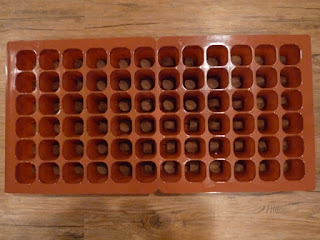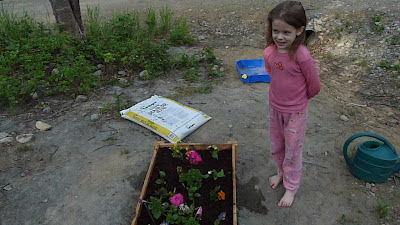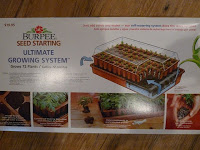by Sue Ryan, an Alaska Master Gardener
As a mother of four, I am always looking for ways to include my
kids in my love for gardening. This spring, I was able to pique their interest
by having them help me start seeds for our summer beds. Not only do kids love
to learn about how things grow, they are also more likely to eat and try new
veggies that they have grown themselves. Devious, I know!
kids in my love for gardening. This spring, I was able to pique their interest
by having them help me start seeds for our summer beds. Not only do kids love
to learn about how things grow, they are also more likely to eat and try new
veggies that they have grown themselves. Devious, I know!
In the past, my starts have been miserable attempts with few of
the actual seedlings surviving long enough to make it to the garden. I had to
supplement heavily with things I purchased from the local nurseries. My former
strategy was to just put my starts in the window, but I learned that winter sun
is inadequate in helping your starts to grow right.
This year I put some of my
new knowledge from the Master Gardener course into use, and purchased a grow light to give my plants a fighting chance.
Self-Watering Mat
I like to try new gadgets so I picked up this Burpee Seed Starting growing system that featured a “self-watering
mat’. (No I wasn’t perked, by Burpee to use their product). I just wanted to
see if this actually made the process any easier and wanted to pass on my
impressions.
mat’. (No I wasn’t perked, by Burpee to use their product). I just wanted to
see if this actually made the process any easier and wanted to pass on my
impressions.
We found that the self-watering mat worked like a charm! We
filled up the bottom tray, as directed with warm water. The mat dips into the
water and wicks up the moisture to keep all of the seedlings moist, without
making them overly wet. Success! I am terrible at making sure my plants get the
right amount of water, I either drown them or starve them. Thankfully my oldest
son took on the task of making sure our tender starts stayed moist.
filled up the bottom tray, as directed with warm water. The mat dips into the
water and wicks up the moisture to keep all of the seedlings moist, without
making them overly wet. Success! I am terrible at making sure my plants get the
right amount of water, I either drown them or starve them. Thankfully my oldest
son took on the task of making sure our tender starts stayed moist.
 The tray had room to start 72 plants. Each hole was filled with a
The tray had room to start 72 plants. Each hole was filled with a“Super Growing Pellet’ which is a type of peat. The kids measured and poured the required amount
of water over the pellets so that they expanded. We found that some of the
pellets expanded nicely, while the majority remained hard. We ended up pulling
out the remaining pellets, adding more water and hand softening them. Then we
placed the softened, growing medium back into the trays.
What to Plant
We took a look at the seeds we had purchased to start early:
broccoli, cilantro, parsley, basil, Nasturtiums, Poppies, and Cosmos. The kids
decided how many of each variety we would plant and then took turns planting
the seeds according to their package directions. Make sure to read the
packages, as each seed needs to be planted at specific depths and some may require
pre-soaking and some seeds need to be sown directly in the ground once danger
of frost is gone.
broccoli, cilantro, parsley, basil, Nasturtiums, Poppies, and Cosmos. The kids
decided how many of each variety we would plant and then took turns planting
the seeds according to their package directions. Make sure to read the
packages, as each seed needs to be planted at specific depths and some may require
pre-soaking and some seeds need to be sown directly in the ground once danger
of frost is gone.
My kids have been diligent in checking on the progress of our starts
over the weeks. They have made sure that the grow light is on in the morning,
and have enjoyed watching tiny green sprouts turn into plants.
over the weeks. They have made sure that the grow light is on in the morning,
and have enjoyed watching tiny green sprouts turn into plants.
The starts were doing so well and sending out massive roots
systems, so I began to transplant some into containers that they will be
filling this summer. In the past, my starts would get too “leggy’ and then
topple over from poor lighting. This year they have grown at a nice rate.
systems, so I began to transplant some into containers that they will be
filling this summer. In the past, my starts would get too “leggy’ and then
topple over from poor lighting. This year they have grown at a nice rate.
Even though you may be tempted by warmer temperatures to put your
plants out when the sun returns, make sure to watch the evening low temps. A
good time to aim for putting your tender new plants out is Memorial Day
weekend. Most danger of frost is gone by then. Some may be able to put their
plants out earlier, depending on where you live.
plants out when the sun returns, make sure to watch the evening low temps. A
good time to aim for putting your tender new plants out is Memorial Day
weekend. Most danger of frost is gone by then. Some may be able to put their
plants out earlier, depending on where you live.
Make sure to harden off your plants before leaving them out cold
turkey. What does this mean? It means gradually getting your tender plants
ready for the great outdoors where they will face wind and drying effects of
the sun. Here is a good article from the Anchorage Daily News on hardening off
your plants.
turkey. What does this mean? It means gradually getting your tender plants
ready for the great outdoors where they will face wind and drying effects of
the sun. Here is a good article from the Anchorage Daily News on hardening off
your plants.
The kids and I will be planting the remaining plants in our
garden here in the next few weeks in our raised garden beds. If you want to
make some inexpensive raised beds, here are free plans from a fellow Alaskan
gardener. She made these from cedar fence boards!
garden here in the next few weeks in our raised garden beds. If you want to
make some inexpensive raised beds, here are free plans from a fellow Alaskan
gardener. She made these from cedar fence boards!
Happy gardening!
About Heidi Rader
Twitter •

